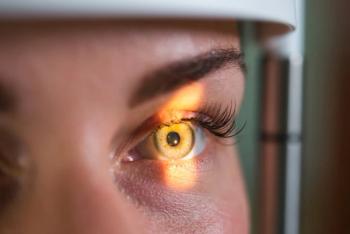
Fitting the future: How technology is refining specialty lens care
Today’s tools let clinicians fine-tune fits with accuracy, while solving old challenges and unlocking complex optical corrections.
Advances in
To explore these developments, the Eye Care Network invited leaders in the optometric field to join in a brief Q&A, sharing their insights on the latest innovations and their impact on patient outcomes.
Joining in the discussion are the following:
- Mile Brujic, OD, FAAO, is a partner of Premier Vision Group, a 4-location optometric practice in Northwest Ohio.
- Christine W. Sindt, OD, FAAO, is a clinical professor of ophthalmology and visual sciences with the University of Iowa Department of Ophthalmology and Visual Sciences in Iowa City. Sindt runs an advanced contact lens clinic, seeing patients primarily by referral or those with complex eye conditions. She notes that her perspective is shaped by this specialized patient population.
Note: Transcript edited lightly for clarity and length.
How have advances in specialty contact lenses improved patient outcomes?
Brujic: Improved designs, material characteristics, and surface treatments have revolutionized the way we care for patients requiring specialty contact lenses. It provides healthier and more comfortable ways to care for these patients while providing them exceptional visual outcomes.
Sindt: Freeform technology allows for more comfortable, more stable lenses. Nuisance issues of the past—such as limbal over vault, inflamed pinguecula, and difficulty adjusting localized areas without causing an issue elsewhere on the lens—have been largely eliminated. The superior stability also allows us to put complex optical powers on the lens. I can confidently improve higher-order aberration by an average of 65% within 2 lenses.
What are the latest strategies for myopia management in pediatric patients?
Brujic: There is a single contact lens that is currently FDA approved to manage myopia progression.1 Several studies have demonstrated benefits with several designs, including orthokeratology, as other options for these patients. Pharmaceuticals that are FDA approved and provide additional levels of consistency over compounded formulations provide simplified solutions for patients. Additionally, a recent approval of an ophthalmic lens to manage myopia progression will open up treatment for patients in which contact lenses and pharmaceuticals cannot be utilized.2
How do you integrate scleral or hybrid lenses into complex corneal cases?
Brujic: I discuss the patient’s condition and provide them with the options for visual correction. I am also astute to the benefits the patient has and what the services and lenses will cost the patient. Communicating this provides the patient the best opportunity to make the best decision.
Sindt: I don't fit hybrid lenses.
My patients travel great distances to come to me. I consider anyone within 2 hours to be my local people. Most of my cases would be considered complex. I choose the lens based on physiology, optics, and the patient's needs or past history. Most of my fits, scleral lenses and gas-permeable lenses, are based on 3D technology (impressions or scans). With complex corneas, a poor fit could result in decomposition of the cornea. Therefore, it is imperative to design the lens correctly and avoid potential problems. I think the key to integration is connecting with the patient and explaining the disease and how lenses work as well as expectation management and potential problems or risks.
Are there pipeline technologies or lens designs that could shift optometric care?
Brujic: The advent of new diagnostics is enhancing the way we detect and monitor corneal disease. Additionally, these technologies are also enhancing the way we fit the lenses as well. Artificial intelligence will likely continue to enhance our ability to best fit specialty lenses.
Sindt: AI will fundamentally shift contact lens fitting for complex disease. Feeding data, such as topographical scans, 3D impression data, facial and ocular imaging, disease states, endothelial scans, etc, will allow us to pre-problem solve and fit lenses instantly. When we can speed up fitting and remove risks, there will be a sea-change.
Mile Brujic, OD, FAAO
E: mile.brujic75@gmail.com
Brujic is a partner of Premier Vision Group, a 4-location optometric practice in Northwest Ohio. He did not indicate any relevant disclosures.
Christine W. Sindt, OD, FAAO
E: christine-sindt@uiowa.edu
Sindt is a clinical professor of ophthalmology and visual sciences with the University of Iowa Department of Ophthalmology and Visual Sciences in Iowa City. Sindt runs an advanced contact lens clinic, seeing patients primarily by referral or those with complex eye conditions. She notes that her perspective is shaped by this specialized patient population. She did not indicate any relevant disclosures.
REFERENCES
FDA approves first contact lens indicated to slow the progression of nearsightedness in children. News release. FDA. November 15, 2019. Accessed November 5, 2025.
https://wayback.archive-it.org/7993/20201222232742/https://www.fda.gov/news-events/press-announcements/fda-approves-first-contact-lens-indicated-slow-progression-nearsightedness-children FDA authorizes marketing of first eyeglass lenses to slow progression of pediatric myopia. News release. FDA. September 25, 2025. Accessed November 5, 2025.
https://www.fda.gov/news-events/press-announcements/fda-authorizes-marketing-first-eyeglass-lenses-slow-progression-pediatric-myopia
Newsletter
Want more insights like this? Subscribe to Optometry Times and get clinical pearls and practice tips delivered straight to your inbox.









































